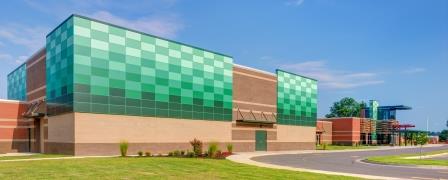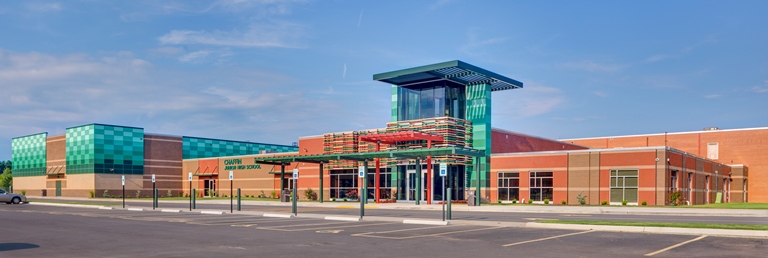When bidding a project, rarely does the coatings contractor need to consider two finish colors, let alone five, but Ken Martin, general manager at Texas Finishing happily tackled a unique project at Chaffin Junior High School in Fort Smith, Ark. In all, 3,500 square feet (325.2 m²) of painted, multi-colored aluminum panels were to be integrated into a massive renovation project with an overall budget of over $8 million dollars. And it all had to be done before school was back in session!
School Colors
Texas Finishing’s role in this fast-track project involved polyvinylidene fluoride (PVDF) paint finishing on aluminum panels. Every panel was coated in a range of colors in-house in Carrollton, Texas, at the company’s 57,000-square-foot (5,295.5 m²) facility. There they had a team of 20 people. After coating, the panels were sent up to a metal fabricator in Tulsa, Okla., called Equus Metal, for final assembly before being sent to the installer for placement.
As Martin explained, “the project came to us for bidding through Equus Metals thanks to our regular business with them. We noticed, first of all, it was several aluminum panels, but they were multiple colors and in our business we typically paint just one to two colors. But this one was several, which is pretty exciting.”
Some clients supply a color code, whereas others ask to match a color with the PVDF. Texas Finishing, though, has a long-term, excellent relationship with coating manufacturer Valspar, which happens to be just a 20-minute drive away. “We chose them to match all of the different colors, then we got samples approved by the customer and our bid,” noted Martin. “This was a fast tracked job, which usually the schools are, so we only have the months from when the summer begins until the fall starts.”
Processes and Procedures
The panels, which were aesthetic and all different sizes and colors, were 1/8-inch (0.3 cm) thick mill-finished new aluminum plates. The first step in the coating process was to run the aluminum through a five-stage pretreatment to clean and etch the aluminum substrate. The crew used a chromate conversion coating supplied by Abrite Chemicals in dip tanks to complete this. This process is what would allow the primer and paint to adhere to the etching.
After the chrome phosphate coating, the panels were taken to the paint line and put on the conveyer belt into the first booth for a coating of primer, Valspar Fluroprime. That layer was applied at a 0.3-mm (0.01 inches) thickness using Graco PRO X2 Electrostatic Handguns, and from there without curing, the color coat is applied right on top. The color is applied in a thickness ranging from 1.0 mm to 1.2 mm (0.04–0.05 inches) utilizing ITW Randsburg Aerobell 33 Electrostatic Automated Guns. After that, both paint and primer are cured at the same time — wet on wet — in the curing oven.
 The entire process took about 9 minutes in a 500° F (260° C) oven, but the temperature of the metal did not get above 465° F (240.6° C). According to the manufacturer’s specifications, with the PVDF the substrate has to be at least 450° F (232.2° C) to cure. After the finished pieces cooled, there was a total of 1.3–1.5 millimeter (0.05–0.06 inches) thickness of finished product coating the aluminum substrate. After cooling, each piece was then packaged and shipped to the fabricator in Tulsa, Okla.
The entire process took about 9 minutes in a 500° F (260° C) oven, but the temperature of the metal did not get above 465° F (240.6° C). According to the manufacturer’s specifications, with the PVDF the substrate has to be at least 450° F (232.2° C) to cure. After the finished pieces cooled, there was a total of 1.3–1.5 millimeter (0.05–0.06 inches) thickness of finished product coating the aluminum substrate. After cooling, each piece was then packaged and shipped to the fabricator in Tulsa, Okla.
Martin went on to note the extreme durability of the finished product, explaining that, “we, as the applicator, expect the color to hold for 20 years to a limited degree, but any color change would be very minor. The specs say it has to be within five delta units, and the surfaces should be regularly cleaned.” Those colors were:
-
395F562 Dark Green Fluropon
- 399A544 Gold Watch CLII Fluropon
- 394F169 Coronado Red Fluropon
- 397A6914 Seawolf Fluropon
- 399A631 Harvest Gold CLII Fluropon
Team Challenge
There was no environmental impact to consider with the project since everything was done in-house. Once the pieces left the shop, they were fully cured and ready to install. “All of our spray booths are contained in a thermal oxidizer that will burn off the VOCs [volatile organic compounds] and clean up the air exhaust before it goes into the atmosphere,” Martin explained. “And all of our painters are fully equipped with PPE [proper protective equipment] while they’re in the spray booths.” The company used 6000 Series 3M half-face respirators as well as 3M hood assemblies for the project.
As a company, Texas Finishing, established in 1975, focuses on mostly architectural work, including projects involving high-rise buildings and curtain wall systems, as well as notable projects painting the extrusions. The company, which is fully regulated by the state of Texas to spray the PVDF, has worked on other notable projects such as AT&T Stadium, the home of the Dallas Cowboys.
The team enjoys their continued strong relationship with Valspar. As Martin explained, “I came to Texas Finishing in 1990, and my boss and I had been really building that relationship back then. Since then, we’ve gone through a couple of reps, but now we’re working closely with [our current reps]. They really know what our needs are and can accommodate us quickly and efficiently.” Having a supportive coatings team — from the applicators to the reps — can help make these types of jobs more positive. And with that — class dismissed!
